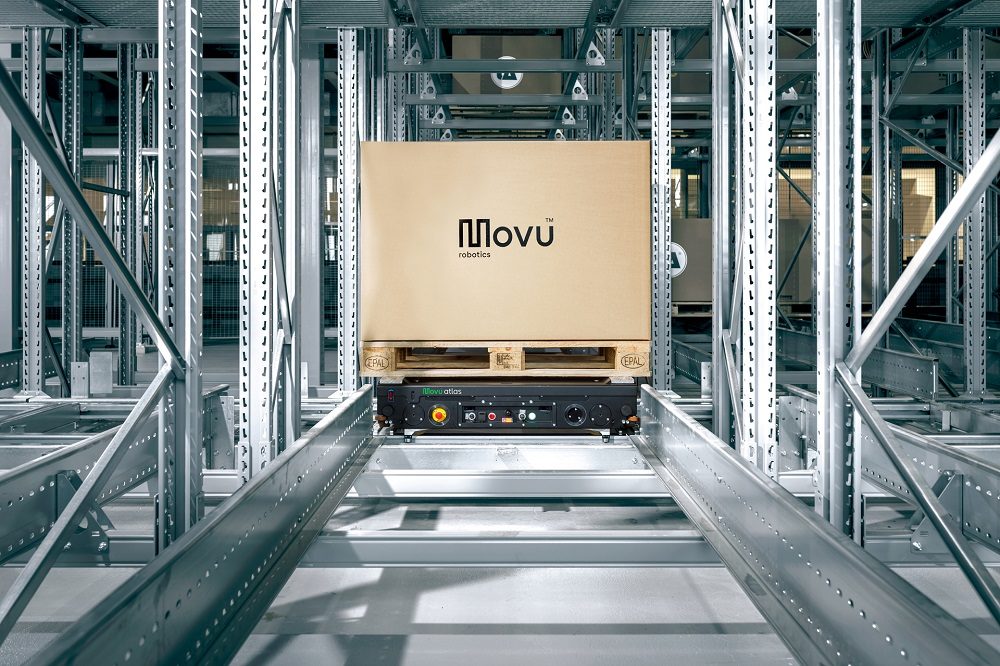Movu Robotic Solutions for Peak Shopping Season

A growing number of companies are adopting robotic solutions in their logistics processes. They provide far greater flexibility than conventional automated handling systems, and can seriously boost productivity, throughput and operational accuracy, even in ‘steady state’ operations. Pallet and bin shuttle systems for automated storage and retrieval are a prime example. With modular design, acting as a set of building blocks to minimize complexity and cost of upgrading, these systems are highly scalable installations can start small and then expand or, if needed, they can downsize just as easily.
Shuttle systems provide a high density, multi-pallet position automated storage and retrieval system that maximizes storage capacity while also removing manual handling, helping to reduce both personnel risk and picking errors. Self-powered robot carriers transport pallets on the rails within the storage lanes of the racking where the pallets are housed, and on the rails of the main lane that runs across the storage lanes it serves. Software manages the shuttle traffic within the system, issuing orders from a Warehouse Management System (WMS).
Using picking robots at the workstations of bin shuttle storage systems add to this flexibility. So will using Autonomous Mobile Robot (AMR) systems for pallets and additional load carriers to provide flexible transport to and from the shuttle systems, as well as used as ‘cobots’ to support order picking operations.
The benefit in terms of handling peaks is the ability to add individual robots – either shuttles, AMRs or picking arms, as demand requires. Much easier than complex reconfiguration of conventional, stacker crane-based automated systems. In addition, with shuttle systems, robots can be moved between the levels of a system to optimize throughput.
With these kind of robotics systems, the joy for companies coping with seasonal peaks is that you don’t have to use, and incur the expense of, the whole capacity. At low volume times, just use a few robots – at the peak, introduce the whole fleet.
Robotics in the form of shuttle systems and AMRs, such as those offered by Movu Robotics, bring easier automation solutions to all warehouses. In particular, they provide opportunities for SMEs, with as few as 5000 pallet locations, to steal a march on larger retail organizations that may have committed to less than flexible, fixed automated systems. With the combination of intelligent software and advanced robot technology, SMEs can leverage the flexibility, speed and performance of this kind of goods-to-person automation as a low-CapEx project. This ensures that when it comes to opportunities for automation, no warehouse is left behind.
Simple, standardized plug and play solutions for warehouse automation and robotics are more accessible and more scalable. They also create an impressive business case for companies. Even operating ‘off-peak’ at well below capacity there is a rapid Return On Investment with labor redeployed to other tasks, such as picking. But it is at peak times when these systems really come into their own, ramping up throughput without any corresponding increase in labor, and minimizing the burden on dispatch and delivery operations. Movu recently installed an atlas 2D robotic shuttle system for a company serving the Chocolate industry, for which Christmas is a significant peak alongside Easter. The flexibility that the shuttle system provides not only helps it to manage these peaks but also facilitates future growth.
By choosing Intelligently designed and flexibly integrated robotic automated warehouse solutions, retailers, manufacturers and logistics operations can meet their fulfilment promises, even during peaks, while saving money. And, importantly, automation isn’t ‘just for Christmas’. It can be scaled and flexed to give benefits throughout the year, in both peak and slack seasons, bringing a multitude of savings. This kind of wise deployment of automation enables a business to not just simply survive, but to thrive.





